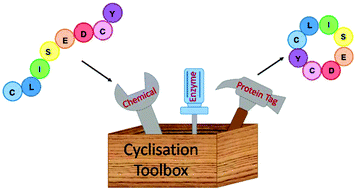Approaches for peptide and protein cyclisation
Abstract
The cyclisation of polypeptides can play a crucial role in exerting biological functions, maintaining stability under harsh conditions and conferring proteolytic resistance, as demonstrated both in nature and in the laboratory. To date, various approaches have been reported for polypeptide cyclisation. These approaches range from the direct linkage of N- and C- termini to the connection of amino acid side chains, which can be applied both in reaction vessels and in living systems. In this review, we categorise the cyclisation approaches into chemical methods (e.g. direct backbone cyclisation, native chemical ligation, aldehyde-based ligations, bioorthogonal reactions, disulphide formation), enzymatic methods (e.g. subtiligase variants, sortases, asparaginyl endopeptidases, transglutaminases, non-ribosomal peptide synthetases) and protein tags (e.g. inteins, engineered protein domains for isopeptide bond formation). The features of each approach and the considerations for selecting an appropriate method of cyclisation are discussed.

- This article is part of the themed collections: Editor’s Collection and Chemical Biology in OBC


 Please wait while we load your content...
Please wait while we load your content...